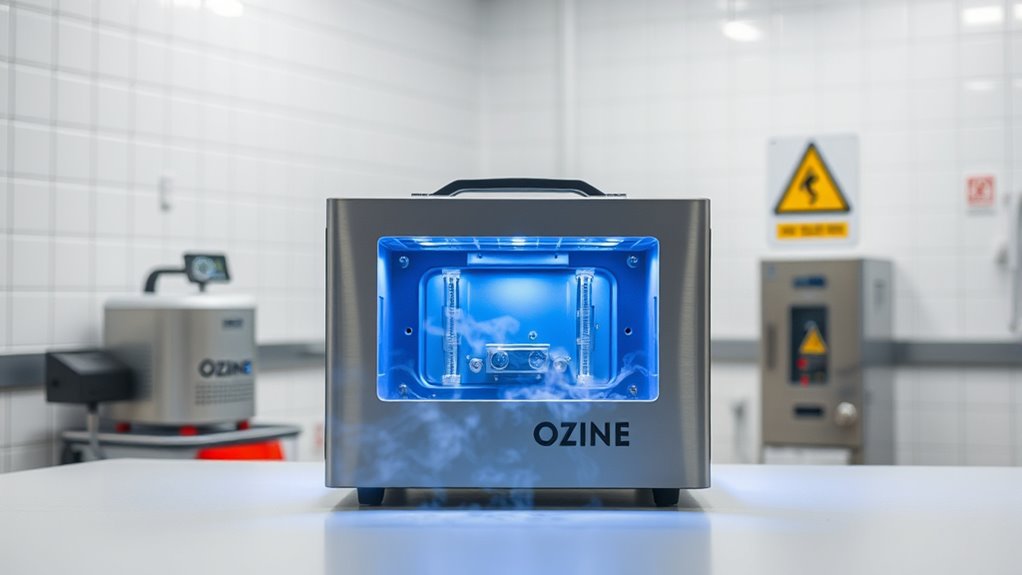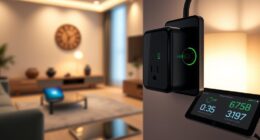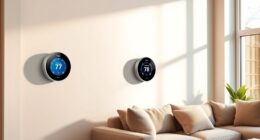Ozone generators are unsafe to use in occupied spaces because ozone can irritate our respiratory systems, worsening conditions like asthma and causing coughing, chest pain, and shortness of breath. Prolonged exposure can even cause lasting lung damage. Many laws also restrict their use indoors due to these health risks. Even if you think a room is unoccupied, residual ozone might still pose dangers or react with materials to create harmful pollutants. If you want to understand how to stay safe, keep exploring this topic further.
Key Takeaways
- Ozone can irritate respiratory systems and worsen asthma symptoms, especially in occupied spaces.
- Using ozone generators in occupied areas poses serious health risks, including lung damage.
- Many regulations prohibit or restrict ozone generator use in occupied spaces due to safety concerns.
- Residual ozone can react with indoor materials, creating harmful secondary pollutants when spaces are occupied.
- Proper use requires unoccupied spaces and adherence to manufacturer and legal guidelines to prevent health hazards.

Ozone generators are powerful devices that produce ozone to eliminate odors, bacteria, and mold from indoor spaces. While they can seem like a quick fix for persistent smells or contamination, it’s essential to understand the risks involved, especially when it comes to health and legality. I want to share some insights to help you make informed decisions about using these devices safely.
First and foremost, the health risks associated with ozone generators are significant. Ozone, in high concentrations, can irritate your respiratory system, leading to coughing, throat discomfort, chest pain, and shortness of breath. For individuals with asthma or other respiratory conditions, exposure can be even more problematic. I’ve seen cases where people thought they were just deodorizing their home, only to experience lingering irritation or worsened allergy symptoms afterward. It’s not just about immediate discomfort either; prolonged or repeated exposure to elevated ozone levels can cause lasting lung damage. That’s why ozone generators are often recommended strictly for unoccupied spaces, and even then, with proper precautions. Additionally, the presence of residual ozone can sometimes lead to chemical reactions with indoor materials, creating secondary pollutants that may be harmful to breathe.
Legal restrictions also come into play when considering ozone generators. Many regions have regulations limiting the use of these devices because of the health hazards they pose. In some places, operating an ozone generator in occupied spaces is outright forbidden, and for good reason. Regulatory agencies like the EPA have issued guidelines emphasizing that ozone generators should only be used in unoccupied rooms, and even then, only for short periods. Failure to comply can result in hefty fines or legal actions, especially if someone is harmed due to improper use. I’ve seen homeowners and business owners underestimate these restrictions, thinking they’re harmless devices, only to face penalties once authorities intervene. It’s critical to check your local laws and manufacturer instructions before attempting to use an ozone generator. Being aware of indoor air quality considerations can help you make safer choices regarding odor removal and sanitation.
Frequently Asked Questions
Are Ozone Generators Legal to Use in Homes?
Yes, ozone generators are legal to use in homes, but there are important safety considerations. Due to legal restrictions in some areas, and the risk to indoor safety, you should only operate them when no one is present. I recommend thoroughly reading the manufacturer’s instructions and local regulations before use. Always guarantee proper ventilation and avoid inhaling ozone, as it can harm your lungs and overall health.
How Long Does It Take to Decontaminate a Space With Ozone?
Decontaminating a space with ozone typically takes about 2 to 4 hours, depending on the size and ozone concentration used. I always recommend ensuring the area is unoccupied during treatment, as higher ozone levels need time to break down safely. After the process, you should ventilate the space thoroughly for at least 30 minutes to reduce ozone concentration to safe levels before re-entry.
Can Ozone Generators Eliminate All Types of Airborne Pathogens?
Think of ozone as a fierce warrior, but even it can’t conquer every airborne pathogen. While ozone effectiveness is impressive against many bacteria and viruses, it doesn’t eliminate all types of airborne pathogens. Some spores and certain viruses are resilient, slipping through the ozone’s grasp. So, I’d say ozone isn’t a magic bullet—it’s a powerful tool, but not a guarantee, especially for every airborne threat out there.
What Are the Signs of Ozone Exposure?
You might experience health symptoms like coughing, sore throat, or chest tightness if exposed to ozone. Sensory effects are common too, such as eye irritation, nasal congestion, or a burning sensation in your lungs. These signs indicate your body is reacting negatively to ozone exposure. If you notice any of these symptoms, it’s best to get to fresh air immediately and seek medical advice if symptoms persist.
Are There Safe Alternatives to Ozone Generators for Air Purification?
You might think ozone generators are your best bet, but I’ve found safer options like HEPA filters and UV sterilization. These alternatives effectively purify air without risking health. HEPA filters trap allergens and pollutants, while UV sterilization kills germs safely. I recommend combining both for ideal results. Unlike ozone generators, these methods are safe for occupied spaces and don’t produce harmful byproducts, making your environment healthier and cleaner.
Conclusion
Think of ozone generators like a wildfire—powerful, but dangerous when uncontrolled. Just as you wouldn’t light a fire in a crowded forest, you shouldn’t bring ozone into occupied spaces. It may seem like a quick fix, but the risks outweigh the benefits. Instead, treat ozone like a wild beast—best kept in the wild, where it can’t harm us. Protect yourself and others by avoiding ozone generators where people are present.









